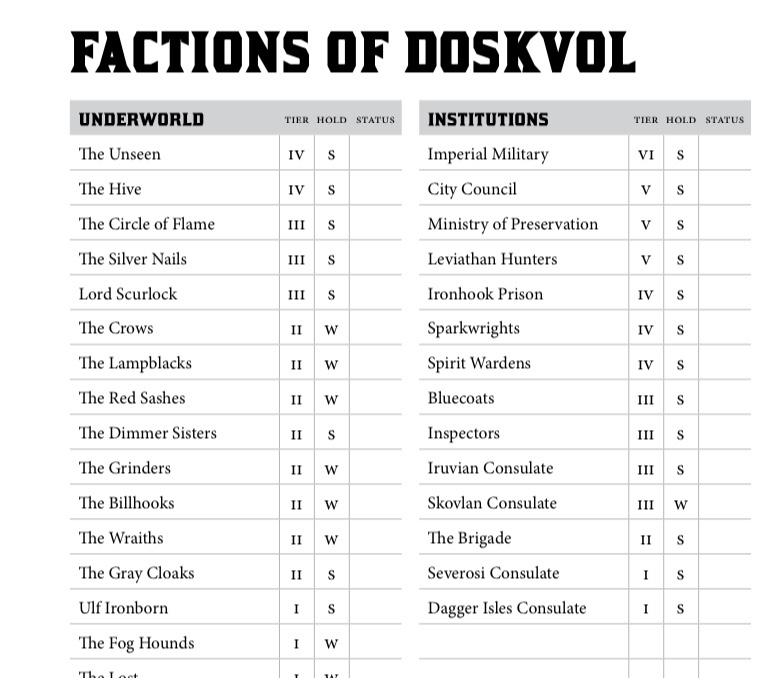I’ve been running Blades in the Dark again lately, since I find its cadence of play works pretty well for me online. However, I seem to have made my life a little more complicated, as the players had a crew idea (a cadre of ex-spies who had survived the fall of their patron – some Burn Notice influence on that) that didn’t point to any particular crew type, and they ended up choosing Smugglers, because they liked the idea of moving secrets around.
This is a cool idea, and I wanted to support it, but I was not prepared. But I am hoping I’ve learned my lesson.
I have a curious take on the relationship between Crews and Jobs in Blades, because I feel like there is a genuine divide between core and non-core crew types. To my mind, Assassins, Bravos & Shadows are the core types because their jobs all rest on a similar underlying pattern of action which the default rules of Blades supports incredibly well. On the other hand, Hawkers and Smugglers (and Grifters) have different patterns that I find require a bit more work to fit.
There is probably a cool way to articulate these as design patterns, but for simplicity, I’m going to illustrate with how I think about job creation when I’m running blades. If I am running a “core” job – that is, assault or stealth – then I need four things, and I benefit from a handful more.
Required
Objective – What is the target of action? (That is, the thing being stolen, the person being killed etc)
Location – Where is this happening?
Opposition – Who is resisting this? (Usually because they own the target, but maybe for other reasons)
Initiation – The point of entry to action. This is recognizable as the missing detail in the planning and engagement rules.
Useful
Complications – These are all the things that are ready to go wrong and shift the job. The most common sort of complication is another interested party – they may not be involved when the job starts, but once the job has started, they might show up or make trouble. Always possible to just make these up on the fly, but past play usually creates a deep reservoir of opportunities to draw from.
Pressure – Why here and now? What’s going on that THIS was the time to run the job, not some better, more perfect time and place? There are all sorts of answers – time pressure, limited windows of opportunity, looming threats and so on, and this is a classic element of the genre (all of them), but this is also a bit of an oddball in Blades. The somewhat wibbly wobbly nature of time paired with the complicated issue of motivation can mean jobs are happening without any pressure to speak of. But if there IS pressure, the game supports it well with clocks.
Value – Why does this macguffin matter? Often this is very straightforward – it’s worth cash – but usually there’s more to it (and even if it’s just worth cash, it’s worth cash to someone.) Is this the means to another end? Is the value of this in the thing it will be traded for? And if it is non-monetary, where is the coin going to come from? You can be a bit hand-wavey about this, but you always want to consider it, because the job payoff is a critical part of the game economy.
Useful Vs Required
Now, to be clear, If I were to ever run a job with only the required elements, I would feel a little naked. The useful elements are the source of a lot of fun and engagement, but I don’t call them required for four reasons.
First, you can run a bare bones job without them, and for a new Blades GM, that might even be the best way to do it.
Second, the useful things can actually be a bit of a crutch – as a GM, we are sometimes pressured to draw in a complication on short notice, and the easiest move is often to bring in something external rather than make the current job more interesting. This is not always a bad move – hell, it’s often a good one – but it can contribute to the actual job feeling like the least important part of play.
Third, there is no consistency in which useful parts you’ll want to bring to bear. You might use some or all of them on any given job, but the precise combination is inconsistent and unpredictable.
Fourth, there may be no reason to add these things because they might already be implicit in the core elements. For example: if the location of the job is the Offices of the Ministry, then the potential complications are baked right in. If the core elements are rich enough, they are often enough.
But even with all those note, this remains a pretty solid model, which can expand or contract according to needs and details. It also is has some curious nuance regarding where each of these data points come from, because they can come from the players, the GM, or just be sort of ambiently known.
To illustrate: The point of initiation is always explicitly authored by the players as part of the planning and engagement phase. The other three points are a bit more flexible.
If the players want to steal something that has already been established as existing in the setting, from a known location, from a faction they have already dealt with, those are all ambiently available information. There may be almost no authorship required to get a job like this started.
I feel like this sort of ambient job is the ideal goal, though I heaven’t really examined why I feel that way. However, I also don’t run across it too often, because usually there are some unknowns that need to get answered, and which unknowns need to get answered seems both highly variable and incredibly important.
The first question is how many of these answers come from the players. For ambient answers, they might all be chosen by the players, or they might require filling in the gaps from the GM. For example, the players might really hate Frakes and want to steal something from him to strike a blow against him. The players are picking the opposition and possibly the location, but they might leave it to the GM to come up with the target, like Frakes’ latest prototype. Alternately, the players might be embracing the privileges of authority and literally just make up some or all of these answers, and let the GM fill in the details.
The more answers that come from the players, the easier things seem to go. I think this is partly because player answers are a proxy for player investment, but also because player answers are a proxy for player clarity.
Because, in contrast, the hardest point for me is when they players have a general intention, but they cannot turn it into action. An example of this is the “Well, we need money – who should we rob?” Situation. Maybe this should never come up in a well run Blades game, but I am only mortal, and have absolutely ended up in that situation, and it’s a fairly serious blank page problem.
In the context of that list of job elements, this may be a GM prompt to offer elements that serve that purpose. That sounds a little fancy, so put more simply, if the players want to make some money but do not know what, then the GM may put forward a suggestion of something valuable that’s ripe for the picking. Of course, in that situation, the GM usually needs to come up with the other elements on the list (Opposition and Location), and that’s fine as far as it goes, but it’s definitely some amount of work. There are tricks to help with this, but the bottom line is simple – unless the players have an idea for the job, the GM needs to fill in most of the gaps.
Not a shocking realization, I know, but I lay it all out there to illustrate something essential about core jobs. While they may end up requiring work on the GM’s part, they require the least amount of work, because other jobs require more.
But that’s a topic for another day.
- Cultists are an even odder case, because they are not defined by the TYPE of action they pursue, but its reason and theme. If you have a crew that smuggles ghosts, the decision to go smuggler vs cult answers very different questions than what the core cycle of play looks like. As a result, Cultists might or might not be core, depending on how the crew works. ↩
- And, yes, it’s true the crew types do not line up one for one with the engagement types. I’m pretty sure this is deliberate, in order to break the idea that a given crew can do only one type of job, and I applaud that. But I think some of the friction comes from the dual masters of the Blades’ emphasis on no-planning and the reader-friendly need to structure these all the same way. ↩
- For Assassination, this list can collapse even further, as objective and opposition may well be the same thing, but we’ll stick with this for simplicity. ↩
- Yes, aggressive player authorship is one solution to this, but I don’t like relying on it piecemeal. If that is at the heart of the game, then awesome, lean into it. But if it’s not, then it tends to be unevenly distributed, without clear practical or social rules around what’s appropriate or not. ↩




